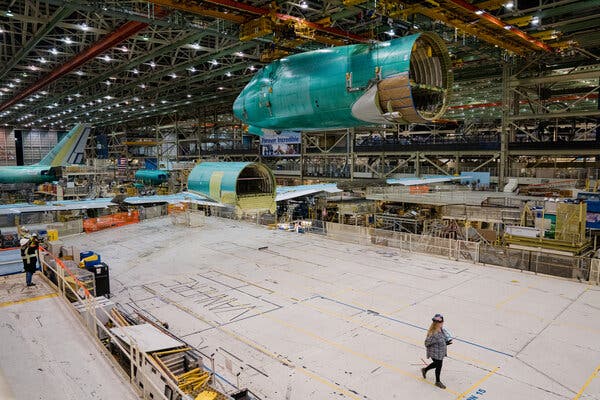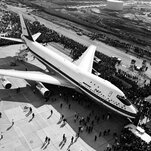
The Last Boeing 747 Leaves the Factory
More than a half-century ago, Boeing unveiled the 747, a massive and striking airplane that captured the public imagination and brought air travel to the masses. The jet has been a workhorse since, ferrying passengers and cargo around the world. But its days are numbered: On Tuesday, Boeing plans to hand over the last 747 it will ever make.
With a distinctive hump, the 747, nicknamed the “Queen of the Skies,” is perhaps the most widely recognizable commercial airplane ever built. The plane transformed air travel and became a symbol of American ingenuity. It could still be flying decades from now, a longevity that aviation historians said was testament to the work that engineers, designers and others put into repeatedly remaking the airplane.
“It’s one of the great ones,” said Shea Oakley, who runs an aviation history consulting firm and is a former executive director of the Aviation Hall of Fame and Museum of New Jersey. “If you had to make a list of the 10 most important airplanes ever built since the Wright Flyer, the 747 needs to be on that list. It was a quantum leap.”
Assembling a goliath

The 747 is composed of about six million parts produced all over the world. But the final, awe-inspiring work of assembling them into an airplane was completed at a factory in Everett, Wash. That plant, generally regarded as the world’s largest building by volume, was built for the 747 in the 1960s. The plant has been used to make other planes, but it has remained home to the 747 down to the final one: No. 1,574.
Seen from a distance, the specialists working on exposed sections of a 747 appear tiny, like miniature surgeons operating on parts of a blue whale. Often under bright, white lights and supported by lifts, rolling staircases and other structures, they install, arrange, assemble and test the guts and shell of the plane.
Production of the last 747 started in September and was typical of how its predecessors were made. In one bay of the factory, workers constructed the wings, starting with the spars that serve as the backbones and then added parts called the ribs and skin. In another bay, they build sections of the body, or fuselage, and then added wiring, plumbing and hydraulics, said Steve Kopecki, director of manufacturing for the 747.
Once the wings were ready, they were hoisted several stories high by a crane and moved into a bay sandwiched between where the wings and fuselage were built. There, they were attached to either side of a stub known as the center wing box. Next, the middle section of the fuselage was lowered and attached to the wings. Then, the front and back sections were lifted and moved into place on either side.
Our Coverage of the Investment World
The decline of the stock and bond markets this year has been painful, and it remains difficult to predict what is in store for the future.
- 2023 Predictions: There are plenty of forecasts coming for where the S&P 500 will be at the end of the year. Should you be paying attention to them?
- May I Speak to a Human?: Younger investors who are navigating market volatility and trying to save for retirement are finding that digital investment platforms lack the personal touch.
- Tips for Investors: When you invest and where matters for taxes. But a few rules of thumb can stave off some nasty surprises.
“That’s the place where the airplane actually finally becomes an airplane,” Mr. Kopecki said.
After the body sections were attached, the landing gear was installed and 14,000-pound counterweights were hung from the wings. Then, the plane was lowered from its supports and allowed to stand on its own, a major milestone.
“If you’ve done that, there are many, many important steps behind you already,” Mr. Kopecki said. “And you have a very clear path of what lies ahead.”
Soon after, flooring, lighting, walls, parts of the flight deck and other interior fixtures were installed. All of the airplane’s systems were tested. Near the end of assembly, the engines were added. Finally, the airplane was rolled out of the factory, through bay doors several stories high that could accommodate the airplane’s 225-foot wingspan.
Outside, fuel systems and other features were checked and the plane embarked on a test flight, landing in Portland for a paint job before flying back. The plane and its systems continued to be evaluated. On Tuesday, it will be handed over to Atlas Air Worldwide, a cargo and passenger airline that will use it to haul goods.
A troubled beginning
The 747’s long life is remarkable partly because its start was so uncertain.
Boeing began designing the airplane in the mid-1960s at the request of Pan American World Airways, a leading airline that filed for bankruptcy protection in 1991. But even then, many people within Boeing were expecting the 747 to soon be supplanted by a supersonic jet the company was developing.
As a result, and to justify their investment, Boeing and Pan Am decided that the plan should be designed with passengers and freight in mind, a choice that would be crucial to its success and determine its unique shape. The designers wanted the nose to lift up so cargo could be loaded more easily. To make that possible, they placed the flight deck above the main cabin, rather than at the front of the plane, creating the 747’s unusual hump.
Over the years, as engineers and designers worked on the plane, Boeing’s financial situation dimmed. Airline orders were slowing and costs for the 747 and the supersonic jet, which the company would abandon in 1971, were soaring. Then, a crisis arrived.
Even as parts of the wing were being made, testing revealed that the load on the outside of the wing was greater than its structure could support. “This was more than a problem; it had the potential to be a showstopper!” Joe Sutter, who led the design of the airplane, wrote in a book, “747: Creating the World’s First Jumbo Jet and Other Adventures From a Life in Aviation,” which was written with Jay Spenser.
Some within the company argued that the wings would need to be wholly redesigned, which Mr. Sutter feared would be so expensive that it would kill the plane. Eventually, his team arrived at a cheaper, simpler solution that involved twisting the outside of the wings to adjust the distribution of pressure in flight. That worked and the airplane rolled out for testing in 1968.
The rise and fall
More than two dozen airlines were already committed to buying the 747 when it was first shown to the public. In 1970, the 747 took its maiden commercial flight, ferrying more than 300 Pan Am passengers to London from New York.
It became an instant public sensation. The four-engine airplane was much larger than any other and could fit hundreds of people in rows with up to 10 seats across. The upper deck, reachable by a spiral staircase, hosted a luxurious lounge. American Airlines had a piano bar installed in the main cabin.
Orders started to flow in, bringing Boeing much-needed revenue. Owning a 747 became a status symbol for airlines. Some companies bought the airplane even though it didn’t quite suit their needs.
The most important reason airlines bought the plane was that the 747 helped them cut costs. Because the airplane could carry so many more passengers in a single trip, airlines could sell tickets more cheaply, making air travel affordable to the masses.
Boeing produced several versions of the airplane in the 1970s and ’80s for different uses and to improve how much it could carry and how far it could fly. In 1989, the company unveiled a major upgrade, the 747-400, which became the plane’s best-selling model. Boeing sold more 747s in the 1990s than in any other decade.
But as popular as the airplane had become, the world was starting to move on.
Smaller, more efficient two-engine airplanes could now fly longer distances. Their smaller size meant airlines could offer direct international routes between smaller cities, such as St. Louis and Frankfurt.
In the mid-90s, Boeing also introduced the 777, which was about as big as the 747. With only two engines, it was more advanced and efficient. A decade later, Boeing’s main rival, Airbus, debuted the A380, which can carry more passengers than the 747. But Airbus struggled to sell the plane and announced the end of production in 2019.
Still, interest in the 747 lingered, particularly for cargo operations. In the early 2010s, Boeing introduced the last model, the 747-8, delivering about 50 passenger versions and more than 100 versions for carrying goods.
A long farewell
For many of the people who worked on the airplane, the delivery of the final 747 is a bittersweet moment. They are proud of their ties to the jet and sad to see its production end.
“You have an airplane that’s kind of done its duty for 50 years,” said Scott Pettersen, who spent nearly four decades as a mechanic on the 747 before retiring in 2016.
Mr. Petterson estimated that he helped to build more than 1,200 747s. His work focused on the middle portion of the jet, known as the 44 section. And he said he was fortunate to spend the final decade of his career alongside his son, Tyler, who worked on the front section.
But despite all that time with the airplane, Mr. Petterson said he had never traveled on one. “I would like to fly in a 747,” he said. “I’m sure it’s a great feeling.”
Some airlines still use the plane for passenger flights, including Lufthansa, Korean Air and Air China. But the 747 has increasingly fallen out of favor with many airlines and will probably end its life carrying cargo.
The last of the airplanes produced were all 747-8 freighters for Atlas Air, which operates the largest 747 fleet in the world and leases out airplanes and crews for cargo or passenger operations. The final 747 will be chartered by an Atlas customer, Kuehne+Nagel, one of the world’s largest transport companies, for use by its subsidiary, Apex Logistics.
For Atlas, the 747 remains an ideal choice because of its reliability, capacity and ability to fly huge amounts of goods between major cargo hubs, said John Dietrich, the company’s president and chief executive. And at least one early decision in the design of the plane continues to pay off.
“That nose-loading capability is going to serve the market well for decades to come,” he said.
Do you work in aviation? The New York Times wants to hear your story. Please share your experiences with us below, and you can learn more about our reporting here. We especially want to hear from people who work for (or used to work for) airports or airlines, or who are part of government agencies that help keep the aviation sector running. We won’t publish any part of your submission without your permission.

